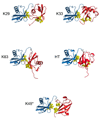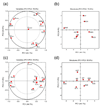Exploring the linkage dependence of polyubiquitin conformations using molecular modeling
- PMID: 19853612
- PMCID: PMC2813430
- DOI: 10.1016/j.jmb.2009.10.039
Exploring the linkage dependence of polyubiquitin conformations using molecular modeling
Abstract
Posttranslational modification of proteins by covalent attachment of a small protein ubiquitin (Ub) or a polymeric chain of Ub molecules (called polyubiquitin) is involved in controlling a vast variety of processes in eukaryotic cells. The question of how different polyubiquitin signals are recognized is central to understanding the specificity of various types of polyubiquitination. In polyubiquitin, monomers are linked to each other via an isopeptide bond between the C-terminal glycine of one Ub and a lysine of the other. The functional outcome of polyubiquitination depends on the particular lysine involved in chain formation and appears to rely on linkage-dependent conformation of polyubiquitin. Thus, K48-linked chains, a universal signal for proteasomal degradation, under physiological conditions adopt a closed conformation where functionally important residues L8, I44, and V70 are sequestered at the interface between two adjacent Ub monomers. By contrast, K63-linked chains, which act as a nonproteolytic regulatory signal, adopt an extended conformation that lacks hydrophobic interubiquitin contact. Little is known about the functional roles of the so-called "noncanonical" chains (linked via K6, K11, K27, K29, or K33, or linked head-to-tail), and no structural information on these chains is available, except for information on the crystal structure of the head-to-tail-linked diubiquitin (Ub(2)). In this study, we use molecular modeling to examine whether any of the noncanonical chains can adopt a closed conformation similar to that in K48-linked polyubiquitin. Our results show that the eight possible Ub(2) chains can be divided into two groups: chains linked via K6, K11, K27, or K48 are predicted to form a closed conformation, whereas chains linked via K29, K33, or K63, or linked head-to-tail are unable to form such a contact due to steric occlusion. These predictions are validated by the known structures of K48-, K63-, and head-to-tail-linked chains. Our study also predicts structural models for Ub(2) chains linked via K6, K11, or K27. The implications of these findings for linkage-selective recognition of noncanonical polyubiquitin signals by various receptors are discussed.
Figures




Similar articles
-
PolyUbiquitin chain linkage topology selects the functions from the underlying binding landscape.PLoS Comput Biol. 2014 Jul 3;10(7):e1003691. doi: 10.1371/journal.pcbi.1003691. eCollection 2014 Jul. PLoS Comput Biol. 2014. PMID: 24992446 Free PMC article.
-
Linkage-specific conformational ensembles of non-canonical polyubiquitin chains.Phys Chem Chem Phys. 2016 Feb 17;18(8):5771-88. doi: 10.1039/c5cp04601g. Phys Chem Chem Phys. 2016. PMID: 26422168 Free PMC article.
-
Linkage via K27 Bestows Ubiquitin Chains with Unique Properties among Polyubiquitins.Structure. 2016 Mar 1;24(3):423-36. doi: 10.1016/j.str.2016.01.007. Epub 2016 Feb 11. Structure. 2016. PMID: 26876099 Free PMC article.
-
Atypical Ubiquitination and Parkinson's Disease.Int J Mol Sci. 2022 Mar 28;23(7):3705. doi: 10.3390/ijms23073705. Int J Mol Sci. 2022. PMID: 35409068 Free PMC article. Review.
-
[Advances in the application of affinity separation for analyzing protein ubiquitination].Se Pu. 2021 Jan;39(1):26-33. doi: 10.3724/SP.J.1123.2020.07005. Se Pu. 2021. PMID: 34227356 Free PMC article. Review. Chinese.
Cited by
-
Branching via K11 and K48 Bestows Ubiquitin Chains with a Unique Interdomain Interface and Enhanced Affinity for Proteasomal Subunit Rpn1.Structure. 2020 Jan 7;28(1):29-43.e6. doi: 10.1016/j.str.2019.10.008. Epub 2019 Oct 31. Structure. 2020. PMID: 31677892 Free PMC article.
-
PolyUbiquitin chain linkage topology selects the functions from the underlying binding landscape.PLoS Comput Biol. 2014 Jul 3;10(7):e1003691. doi: 10.1371/journal.pcbi.1003691. eCollection 2014 Jul. PLoS Comput Biol. 2014. PMID: 24992446 Free PMC article.
-
Structural Basis for the Inhibitory Effects of Ubistatins in the Ubiquitin-Proteasome Pathway.Structure. 2017 Dec 5;25(12):1839-1855.e11. doi: 10.1016/j.str.2017.10.007. Epub 2017 Nov 16. Structure. 2017. PMID: 29153505 Free PMC article.
-
Linkage-specific conformational ensembles of non-canonical polyubiquitin chains.Phys Chem Chem Phys. 2016 Feb 17;18(8):5771-88. doi: 10.1039/c5cp04601g. Phys Chem Chem Phys. 2016. PMID: 26422168 Free PMC article.
-
Segmental isotopic labeling of ubiquitin chains to unravel monomer-specific molecular behavior.Angew Chem Int Ed Engl. 2011 Nov 18;50(47):11210-4. doi: 10.1002/anie.201104649. Epub 2011 Sep 28. Angew Chem Int Ed Engl. 2011. PMID: 21957015 Free PMC article. No abstract available.
References
-
- Wilkinson K. Ubiquitin: a Nobel protein. Cell. 2004;119:741–745. - PubMed
-
- Hershko A, Ciechanover A. The ubiquitin system. Annu Rev Biochem. 1998;67:425–479. - PubMed
-
- Pickart CM, Fushman D. Polyubiquitin chains: polymeric protein signals. Curr Opin Chem Biol. 2004;8:610–616. - PubMed
-
- Cook WJ, Jeffrey LC, Carson M, Chen Z, Pickart CM. Structure of a diubiquitin conjugate and a model for interaction with ubiquitin conjugating enzyme (E2) J Biol Chem. 1992;267:16467–16471. - PubMed
Publication types
MeSH terms
Substances
Grants and funding
LinkOut - more resources
Full Text Sources

